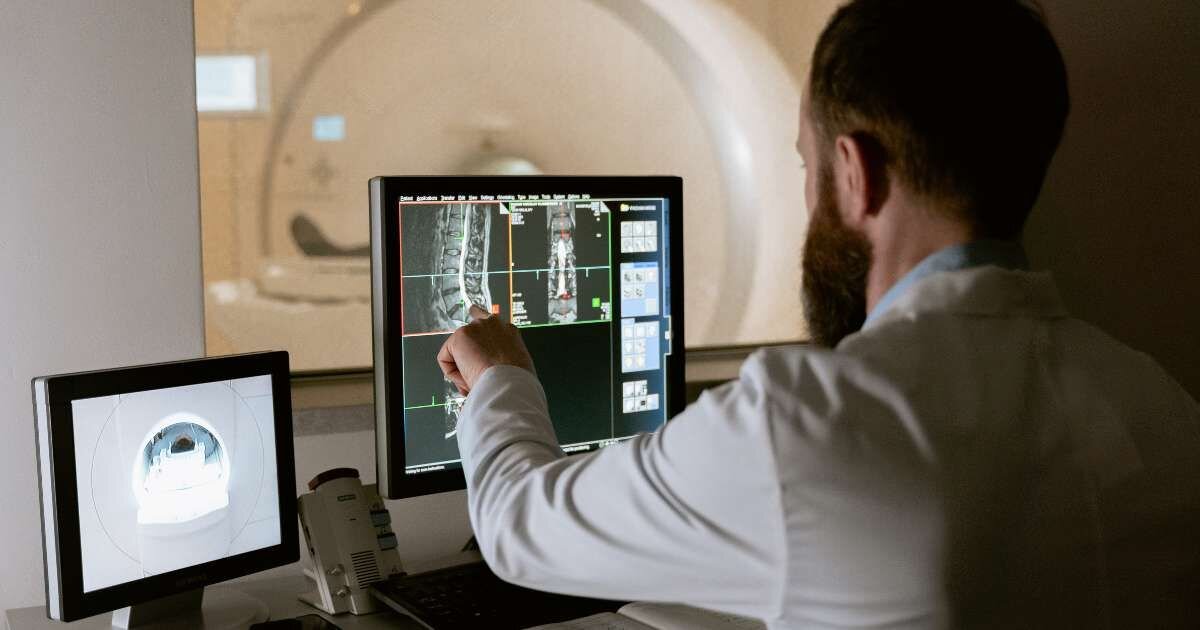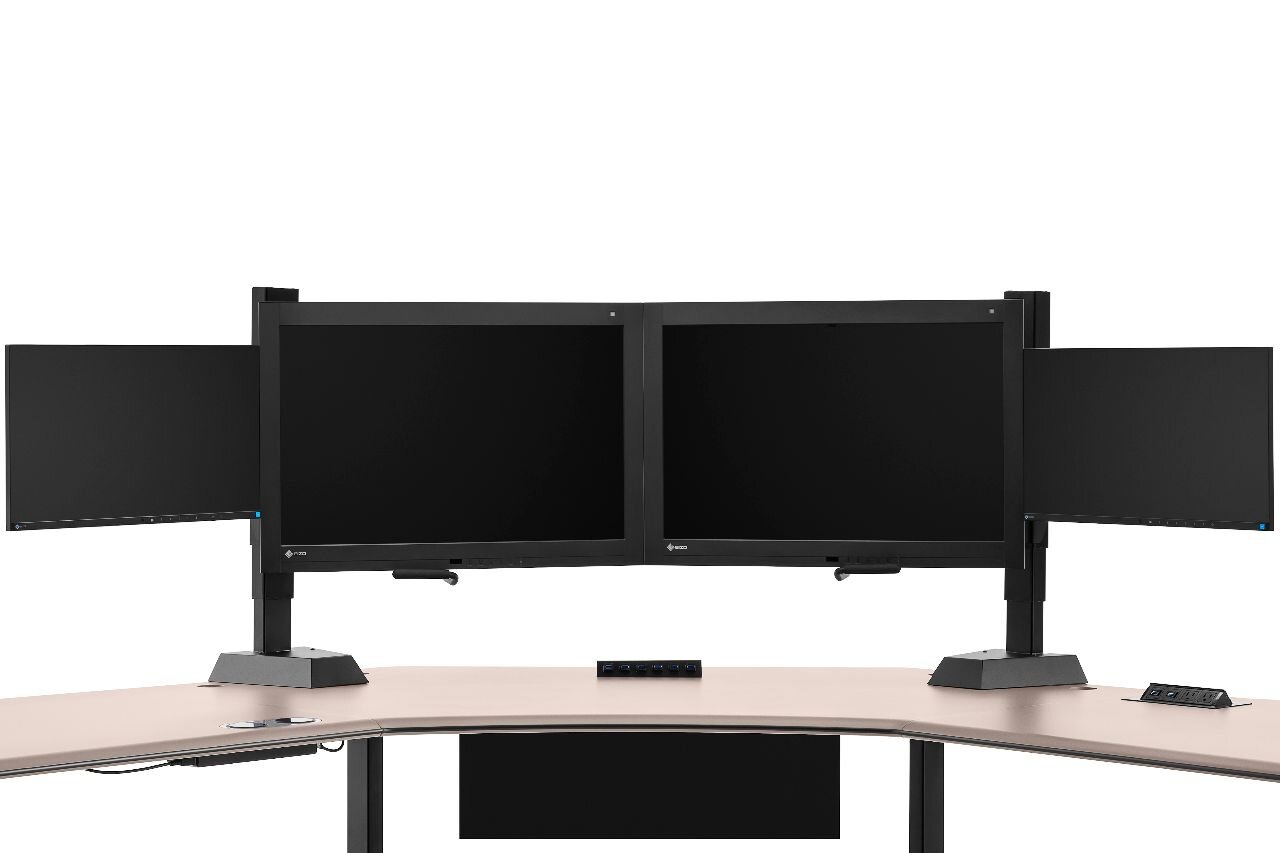
We collect basic website visitor information on this website and store it in cookies. We also utilize Google Analytics to track page view information to assist us in improving our website.

Many of the occupational hazards that come with radiology are well known – exposure to radiation, mental and physical stress, and more. However, what people may not know is the risk of the sedentary nature of the job, and how it can add to the potential health risks to radiologists and imaging professionals.
On average, radiologists can spend more than 8 hours a day sitting at their computers and workstations. By understanding the risk of being sedentary in radiology and how it impacts health, we can find ways to help maximize the comfortability and sustainability of long hours at a workstation.
It’s also essential for those working in the profession to understand the hazard so they know how to protect themselves and their health.
Luckily, as one of the leading suppliers of ergonomic workstations, RedRick Technologies has all the tips you need to add movement and mobility to your daily routine.
Due to the sedentary nature of radiology, additional stress can be placed on the radiologist’s health, body and overall mental wellbeing, causing a decrease in overall job satisfaction. It’s also believed that the stress associated with a sedentary work environment could be exasperated by a poor workstation without proper ergonomics.
It’s possible that this lack of ergonomics could lead to work-related musculoskeletal issues. After all, 30-60% of radiologists have reported issues such as eyestrain, back and neck strain, and headaches.
There are several risks that come with a sedentary lifestyle, even outside of radiology. The general population can face several health problems that increase the risk of morbidity and mortality, including:
Hypertension
Obesity
Diabetes
There are other diseases that can be caused or exasperated by a sedentary lifestyle, such as cardiovascular disease and several types of cancer with increased mortality rates. It goes without saying that the way we live our day-to-day lives has a direct impact on our overall physical and mental health - and that includes radiologists who work in a sedentary and high-demand job.
Research shows that being sedentary contributes to several causes of mortality; more than even the ones we’ve mentioned. According to the World Health Organization, this includes health factors such as diabetes, obesity, increased risk of colon cancer, high blood pressure, osteoporosis, lipid disorders, and perhaps the most underrated - depression and anxiety.
While you may think that simply exercising outside of your sedentary job is the answer, it doesn’t negate the negative effects of hours spent sitting in minimal movement, which has been shown to contribute to a slower metabolism along with other negative side effects. Instead, the ergonomics experts at RedRick Technologies suggest implementing additional movement into the average radiology workday, ranging from improved ergonomics to increasing activity.
While much of a diagnostic radiologist’s work is sedentary, there are strategies to reduce the health risks associated with prolonged sitting. Experts studying sedentary behavior recommend that individuals can improve their health by incorporating the concept of NEAT into their daily routines.
NEAT, otherwise known as "non-exercise activity thermogenesis," refers to the energy expended through daily activities such as walking, standing, sitting, and fidgeting. It excludes activities like sleeping, eating, and formal exercise.
While it might not be the same as doing an intense HIT workout, even low-energy activities such as fidgeting have been shown to be effective in keeping your metabolic rate up while preventing weight gain.
Radiologists can incorporate small, fidgeting-like activities into their work to increase energy expenditure and reduce the negative effects of prolonged sitting. These activities include using a computer mouse, typing, and tapping one’s foot - or even just getting up to do a bit of stretching.
Beyond these minor adjustments, it’s also suggested radiologists explore additional ways to increase NEAT and help protect against chronic health problems related to a sedentary lifestyle.
Hold on - don’t let us lose you just yet. Drinking more water has several health benefits - not to mention it’s literally required for several important bodily functions. It even has the added benefit of suppressing appetite and helping to keep your weight gain under control.
If you’re not the type to focus on drinking your eight a day, you can eat more foods higher in water content which can help reduce caloric intake - meaning you’re more likely to be satisfied after eating.
But how can you use this to increase NEAT?
Turn drinking water into an activity. Use a smaller water bottle so every time it needs a refill, you must get up to go refill it. That short walk from your desk to the water refilling station, even 3-5 times a day gets you moving. You can also keep your food in the lunchroom so you need to walk to retrieve snacks and meals.
Research has shown that even standing motionless or standing while fidgeting can increase your NEAT significantly rather than simply sitting and doing nothing. Most ergonomic workstations are designed to be elevated to allow some reading and dictating to be done in an upright position.
It’s essential as well to add extra activities to do while you’re standing to increase your overall energy expenditure rather than standing motionless. It’s important to bear in mind that prolonged periods of standing in one position could cause back pain and venous stasis - so it’s a good idea to keep yourself moving.

There are several documented benefits that come with walking, including increased calorie expenditure, increased cardiovascular fitness, strengthen bones, reduce excess body fat, and boost muscle power and endurance.
Rather than sending over an email regarding a patient, walk down the hall and have a conversation with a coworker about the findings face-to-face. This doesn’t just increase communication and make you feel a little less alone in the workplace, you’re taking measures to bolster your health.
It also provides a much-needed break which can give your mind the mental refreshment required, as well as reducing eye strain to boot.
Luckily, your workstation can be customized to suit your needs. If you have an ergonomically optimized workstation, it should be easy enough for you to do simple exercises at your desk.
With the right amount of space, you could bring in an under-the-desk treadmill and spend short periods of time walking in an upright position. But, if you don’t have that capability, you can also do simple exercises such as neck rolls, spinal twists, leg lifts, and side stretches.
Even very basic exercises like this can reduce fatigue and increase your NEAT expenditure and usually only take a few minutes to complete each day.

Now, these are more general suggestions - but even radiologists can benefit from the following increases in activity/actions in the workday to keep metabolism elevated and reduce the likelihood of chronic diseases exasperated by being sedentary.
It isn’t just about what you do at work - you can make lifestyle changes that will help ensure the longevity of radiologists' health in the long-term.
Boost Your Fiber Intake: Incorporating more fiber into your diet not only keeps you feeling fuller for longer but also helps reduce the risk of obesity, hypertension, diabetes, coronary artery disease, and stroke. Think of fiber as your body’s natural way to promote prolonged satiety and overall well-being.
Mind Your Calories: Being aware of your caloric intake versus your energy expenditure is crucial. It’s about finding that balance between what you consume and how much you move. Staying mindful of this balance helps you maintain a healthy weight and energy levels.
Prioritize Quality Sleep: Aim for 7-9 hours of restful, uninterrupted sleep each night. Consistently getting less than 4 hours of sleep can reduce your metabolism over time, making it harder to maintain a healthy weight and energy levels.
Move Every Hour: Set a reminder on your phone or smartwatch to stand up, stretch, or move for the last 5 minutes of each hour. This simple habit can help counteract the negative effects of prolonged sitting and keep your circulation going.
Track Your Progress: Consider using a smart device like your phone or smartwatch to track your daily steps, food, and water intake. By monitoring your activity levels, you can make small, meaningful improvements each day that add up to big health benefits over time.
RedRick Technologies designs and develops top quality ergonomic workspaces for healthcare professionals ranging from workstations, monitor mounting solutions, accessories, as well as peripherals.
We’ve worked for over two decades in the ergonomic workstation space and have extensive knowledge on how to optimize radiology reading rooms. We have your best interest at heart and aim to optimally support professionals so they can provide the best patient care.
Hopefully, this blog gave you some ideas on how to improve your health as a radiologist. For more information on our ergonomic solutions, see our website for more details.